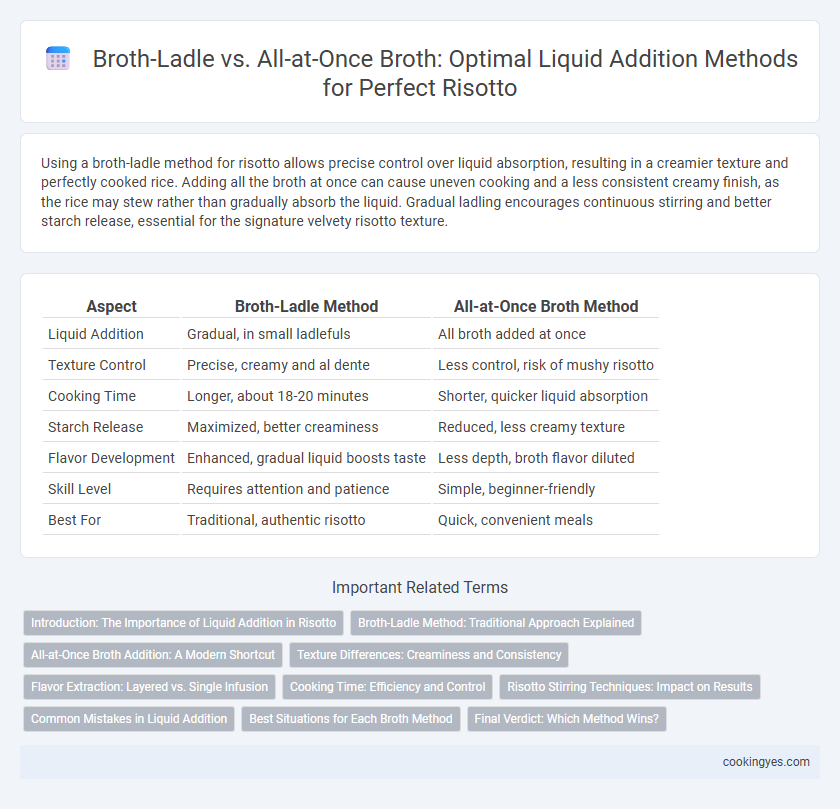Using a broth-ladle method for risotto allows precise control over liquid absorption, resulting in a creamier texture and perfectly cooked rice. Adding all the broth at once can cause uneven cooking and a less consistent creamy finish, as the rice may stew rather than gradually absorb the liquid. Gradual ladling encourages continuous stirring and better starch release, essential for the signature velvety risotto texture.
Table of Comparison
| Aspect | Broth-Ladle Method | All-at-Once Broth Method |
|---|---|---|
| Liquid Addition | Gradual, in small ladlefuls | All broth added at once |
| Texture Control | Precise, creamy and al dente | Less control, risk of mushy risotto |
| Cooking Time | Longer, about 18-20 minutes | Shorter, quicker liquid absorption |
| Starch Release | Maximized, better creaminess | Reduced, less creamy texture |
| Flavor Development | Enhanced, gradual liquid boosts taste | Less depth, broth flavor diluted |
| Skill Level | Requires attention and patience | Simple, beginner-friendly |
| Best For | Traditional, authentic risotto | Quick, convenient meals |
Introduction: The Importance of Liquid Addition in Risotto
Precise liquid addition techniques significantly impact risotto's texture and creaminess, with broth ladling offering gradual absorption that enhances flavor integration and starch release. All-at-once broth addition can risk uneven cooking and a less creamy consistency due to rapid starch gelatinization. Mastering broth-ladle versus all-at-once methods optimizes risotto's signature creamy mouthfeel and balanced taste profile.
Broth-Ladle Method: Traditional Approach Explained
The broth-ladle method, a traditional approach in risotto preparation, involves adding warm broth gradually with a ladle, allowing each addition to be absorbed fully before the next. This technique promotes a creamy texture and enhances flavor integration by controlling starch release from the Arborio rice. Slow, steady liquid incorporation distinguishes this method, fostering a rich, velvety consistency essential to classic Italian risotto.
All-at-Once Broth Addition: A Modern Shortcut
All-at-once broth addition in risotto accelerates the cooking process by pouring the entire liquid volume at once, reducing constant stirring and attention. This modern shortcut preserves the creamy texture while saving preparation time, making it ideal for busy cooks seeking efficiency without sacrificing flavor. The method relies on using a well-stirred broth and maintaining a consistent heat to ensure proper starch absorption and an evenly cooked risotto.
Texture Differences: Creaminess and Consistency
Using a broth-ladle method for risotto allows gradual liquid addition, promoting starch release and resulting in a creamier, more velvety texture. The all-at-once broth technique tends to produce a firmer consistency with less creamy mouthfeel due to reduced starch gelatinization. Controlled liquid integration is essential for achieving the traditional smooth and luscious risotto texture.
Flavor Extraction: Layered vs. Single Infusion
Using a broth-ladle technique for risotto allows gradual liquid addition, promoting layered flavor extraction as each ladle infuses the rice with concentrated broth essence. In contrast, the all-at-once broth method results in a single infusion, which may limit depth and complexity of flavor development. Layered infusion enhances taste nuances by allowing the rice to absorb broth progressively, intensifying the overall richness of the dish.
Cooking Time: Efficiency and Control
Using a broth ladle to add liquid incrementally during risotto cooking allows precise control over the starch release and texture, optimizing creaminess and preventing overcooking. The all-at-once broth method reduces cooking time but risks uneven cooking and less consistent texture. Incremental ladling enhances efficiency by enabling gradual absorption, resulting in a perfectly cooked risotto with balanced moisture and flavor.
Risotto Stirring Techniques: Impact on Results
Using the broth-ladle method for risotto allows gradual absorption and better control over the rice's texture, resulting in a creamier, more consistent dish. Adding all-at-once broth reduces the need for constant stirring, but can lead to uneven cooking and a less creamy finish. Mastering stirring techniques with incremental liquid addition enhances starch release and promotes optimal risotto creaminess.
Common Mistakes in Liquid Addition
Common mistakes in liquid addition when making risotto include adding all the broth at once, which can lead to uneven cooking and a mushy texture due to excess liquid absorption. Using a broth-ladle technique allows for gradual, controlled liquid incorporation, ensuring the rice releases starch properly for a creamy consistency. Over-pouring broth too quickly often results in a loss of the signature al dente bite essential to authentic risotto.
Best Situations for Each Broth Method
Using a broth-ladle method allows precise control over liquid addition, ideal for achieving a creamy risotto texture when cooking small portions or experimenting with flavor infusions. All-at-once broth pouring suits time-efficient cooking and larger batches, where rapid absorption is preferred over incremental texture control. Selecting the method depends on balancing desired texture, cooking time, and recipe scale for optimal risotto results.
Final Verdict: Which Method Wins?
Ladle-by-ladle broth addition offers precise control over rice texture, releasing starch gradually to create a creamier risotto with optimal al dente bite. The all-at-once method risks uneven cooking and less refined consistency due to rapid starch absorption and less gradual temperature regulation. Chefs favor ladle-by-ladle broth for superior flavor depth and silky mouthfeel, making it the preferred technique in authentic Italian risotto preparation.
Broth-ladle vs All-at-once broth for liquid addition Infographic

 cookingyes.com
cookingyes.com